As the global population continues to grow, the demand for animal feed, is increasing. Animal feed and fodder are crucial inputs for the dairy and poultry industries. Traditional food sources are facing challenges. We need to address agriculture practices, rising costs and environmental concerns. This article covers- Azolla Cultivation for Livestock Feed
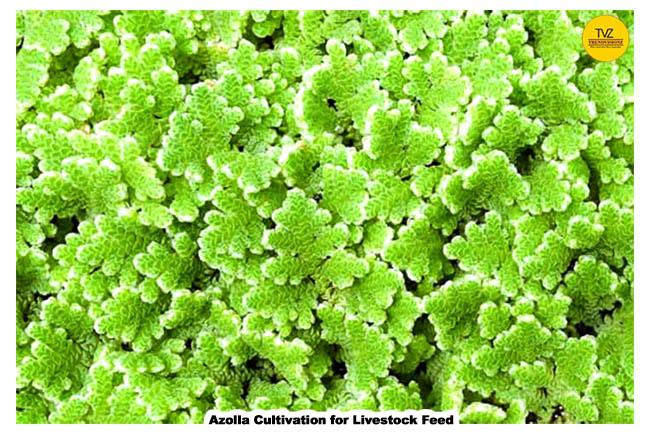
Azolla, a small aquatic wonder fern, emerged as a sustainable and profitable solution. for protein production for livestock. Azolla cultivation offers many benefits.
This comprehensive guide will explore the potential of Azolla farming. Highlight a step-by-step approach to cultivate and use Azolla as livestock feed.
Also Read:
- Top Agritech Startups Fueling Agriculture Growth in India
- Types Of Cloud Services In Everyday Life: Driving Business Growth
What is Azolla?
Discover the Wonder Fern: Azolla
Azolla is an aquatic fern with a slender, branched, floating. Each leaf consists of a dense aerial dorsal lobe containing green chlorophyll. It has a larger, thin, colorless, floating ventral lobe. Upon initial inspection, the fern resembles floating moss. The roots of Azolla are slender and hang in the water beneath the foliage.
An educational film on Azolla, the miracle fern super plant, demonstrating its cultivation in India for year-round green fodder availability for livestock such as cows, buffalo, sheep, goats, and poultry. It describes how to grow Azolla as a feed plant in paddy fields and its numerous advantages for profitable cultivation.
Azolla: A Remarkable Aquatic Fern
In the family Salviria, the marvel Azolla fern is a genus of seven distinct species. It is a fast-growing plant with the ability to fix atmospheric nitrogen. Mainly due its symbiotic relationship with the cyanobacterium Anabaena azollae. This makes Azolla an excellent biofertilizer. Also an ideal protein source for livestock feed.
Also Known as- mosquito fern, water fern, fairy moss and duckweed fern.
Unveiling Azolla: A Comprehensive Guide from Start to Finish
Discover the wonders of Azolla in this insightful video that takes you on a journey. Learn how to cultivate Azolla at home or on the farm, Understand from start to finish its uses and benefits. Explore the step-by-step process of harvesting Azolla for cattle feed and chicken feed. Whether you’re an agricultural enthusiast or a nature lover, this guide will amaze you. Watch now and embrace the green revolution!
Can Azolla: The Wonder Fern Feed Your Livestock and Save the Planet?
Azolla, also known as the “wonder fern,” can reduce the feed and fodder crisis. Azolla: the nutrient-rich supplement, is rich in protein, essential amino acids, and minerals. It can increase the growth and milk production of animals.
Azolla cultivation in integrated agricultural systems can counteract feed scarcity. One acre of azolla can give 540–720 kg of protein per month. Providing a viable solution to feed livestock.

Sustainable Protein Production for Livestock
As per a recent study, there will be 9 billion people, by 2050 on Earth. This will push demand for increased for meat and dairy products. These industries rely on plant protein sources to feed livestock. But, the traditional protein sources like soybeans and maize are admist challenges. Time to explore, alternative protein sources need to meet the growing protein demand. Azolla presents a promising solution.
Where Does Azolla Grow?
As a result of its flexibility, Azolla can grow in a wide range of countries and climatic zones. It flourishes in temperate, tropical, and subtropical climates. It needs average temperatures ranging from 10°C to 35°C.
Azolla grows in China, India, Vietnam, Indonesia and Philippines. It is also grown in Thailand, Bangladesh, Nigeria, Ghana, Brazil, and United States. It thrives in nutrient-rich water bodies such as ponds, lakes, and slow-moving streams.
Because of its ability to float and grow, it is a flexible and sustainable plant. Useful resource for animal feed and environmental conservation in various places worldwide.
7 Ways Azolla: The Wonder Fern Can Revolutionize Livestock Feeding and Combat Climate Change
Advantages of Azolla Farming
Azolla, also known as the “wonder plant,” has a lot of benefits that can change how we feed animals and help fight climate change. Here are seven ways that it animal farming:
1. Rich Nutrient Supplement
The protein in Azolla rich in essential amino acids, vitamins, and minerals. It contains approximately 25-35% protein on a dry weight basis. This makes it comparable to traditional protein sources like soybeans.
| Chemical Composition of Azolla | |
| Proximate constituent % on DM basis | % on DM basis |
| Dry matter 8.42 ±0.27 | Dry matter 8.42 ±0.27 |
| Crude protein 20.20±0.64 | Crude protein 20.20±0.64 |
| Ether extract 3.53±0.28 | Ether extract 3.53±0.28 |
| Crude fiber 12.12±0.12 | Crude fiber 12.12±0.12 |
| Ash 15.53±0.30 | Ash 15.53±0.30 |
| Nitrogen free extract 48.62±0.93 | Nitrogen free extract 48.62±0.93 |
| Organic matter 84.47±.30 | Organic matter 84.47±.30 |
| NDF 35.18±0.42 | NDF 35.18±0.42 |
| ADF | ADF 45.88±0.15 |
| Source: uknowledge | |
2. Azolla in Animal Farming
Feed for cattle is an important. It provides nutrients livestock need to makes them more productive. They need the right food to help animals grow as well as they can. Using Azolla makes sure that animal farming is profitable.
3. Azolla Benefits for Chicken
Azolla benefits chickens by providing a protein-rich feed supplemen. It helps in faster growth, higher egg production, and healthier birds.
4. Cost-effective farming
Azolla ponds don’t cost much to set up, which saves a lot of money compared to expensive industrial feeds. When animals eat Azolla, they grow faster and give more milk, which makes farms more profitable.
5. Rapid Growth and High Yield
Azolla is a highly productive plant that can double its biomass every few days under optimal conditions. This rapid growth rate allows for frequent harvests, providing a continuous and abundant supply of feed. Azolla cultivation can yield significant quantities of biomass for large-scale protein production.
6. Sequestering Carbon
Because Azolla is a natural carbon sink. It absorbs carbon dioxide (CO2) from the air as it grows quickly. As a natural carbon sink, it helps reduce the effects of climate change. This makes it an important part of sustainable farming methods that reduce greenhouse gas emissions.
7. Water conservation
Azolla helps save water because it grows well in bodies of water. Animal Feed production not needing watering, is good for sustainable farming.
Azolla as a Bio-Fertilizer: A Green Revolution
Azolla pinnata is a species of fern known for how quickly it grows and how it can fix nitrogen. The cyanobacterium- Anabaena azollae has the remarkable ability to fix atmospheric nitrogen. This means that Azolla can convert nitrogen gas from the air into a form that plants can use.
Nitrogen fixation by Azolla makes the soil richer, reducing the need for chemical fertilizers.

Support for Biodiversity
Azolla ponds help create different ecosystems. It is good for aquatic animals and makes the environment more resilient.
Adaptability to Various Environments
Key advantages of Azolla farming is adaptability to different climatic and environmental conditions. Perfect for small-scale as well as large-scale farming. It has the potential for widespread adoption in various regions.
By feeding Azolla to livestock, farmers can change the way they do business. Making agriculture more sustainable, and have a good effect on the environment. We can create a cleaner and more prosperous future using Azolla’s potential.
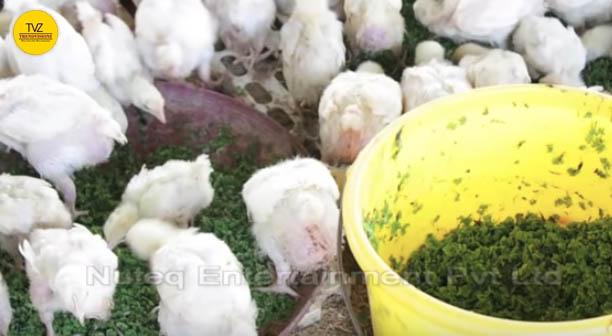
Azolla Farming : Sustainable and Affordable Livestock Feed
NARDEP Azolla Cultivation Method
Navadarshanam Rural Development Programme method is growing Azolla in small ponds or tanks. The method includes:
- Giving the plants enough light.
- Controlling the water’s pH.
- Ensuring they get enough air.
Azolla is grown and picked , so it can a nutrient-rich feed supplement for animals that is also sustainable.
Azolla Cultivation Steps: Supercharge Farming Practices
1. Selecting the Cultivation Area
Cultivate Azolla in ponds, ditches, or any closed body of water. The first step is to select an appropriate cultivation area. This will base on the desired quantity of Azolla. For a suitable small-scale cultivation, a pond with dimensions of 2m in length and 1m in width is ideal. The area should receive enough sunlight. It should be accessible. For activities like maintenance and harvesting.

2. Preparing the Cultivation Area
Prepare the site by levelling the ground and creating the pond structure. Lay old plastic sacks or sheets at the bottom of the pond to provide a barrier. It helps to prevent the growth of unwanted vegetation. Cover the entire pond with durable plastic sheets of suitable thickness. It helps to keep water and provides a controlled environment for Azolla growth. Secure the sides of the plastic sheets by placing bricks or stones on the side walls.
3. Preparing the Bed
Spread approximately 25 kg of clean, fertile soil across the pond’s surface. The soil should be rich in nutrients to support Azolla growth. To enhance the soil’s fertility, apply a mixture of 5 kg of well-rotted cow dung and 30g of rock phosphate (rajphos or musoorie phos) over the soil. This mixture provides essential nutrients and minerals necessary for Azolla growth.
4. Maintaining Water Depth and Nutrient Concentration
The depth in the pond for Azolla Cultivation should be maintain at approx 10 cm. This depth allows for optimal Azolla growth and ensures efficient nutrient uptake. Based on the pond’s area, calculate the Azolla required. A recommended dosage of 500g of Azolla culture per square meter of the pond. Introduce the Azolla culture into the water and allow it to spread. Cover the entire surface of the pond within 1-2 weeks. This indicates that the Azolla is ready for harvesting.
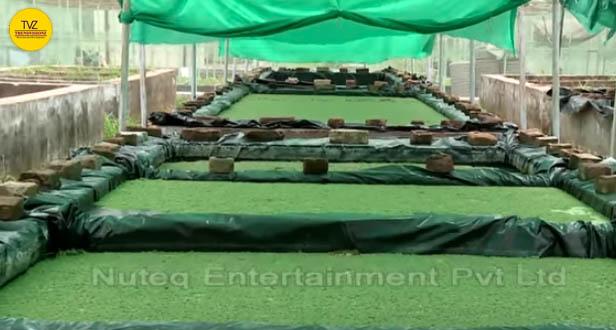
5. Proper Nutrient Management
To maintain optimal nutrient levels for Azolla growth, must to check and manage the nutrient concentration. Test the water’s pH and adjust it to a range of 5.5-7, which is favorable for Azolla growth. Additionally, add a mixture of cow dung and rock phosphate to the pond to replenish essential nutrients. This nutrient management ensures the continuous growth and productivity of Azolla.
6. Azolla Harvesting
Once the Azolla has covered the pond’s surface, it is ready for harvesting. Use a scoop net or install a floating ring system to harvest the Azolla. Remove excess biomass to prevent overcrowding and maintain optimal growth conditions. Azolla is in use as a feed source for various livestock, including chickens, pigs, goats, ducks, and cows. It is also taken for compost piles or used as a biofertilizer to enrich the soil. The high protein content and nutritional value of Azolla make it an ideal supplement. For animal feed and organic farming practices.
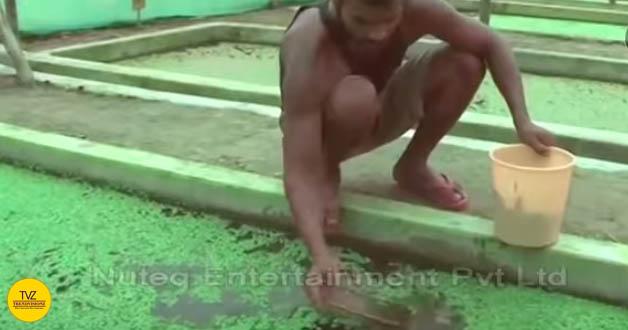
Best Practices for Azolla Farming as Livestock Feed
1. Nutrient Supplementation
To ensure optimal growth and nutritional value of Azolla, it is important to supplement the cultivation. Add organic fertilizers- cow dung/poultry manure to provide nitrogen and essential nutrients. Supplementation enhances quality of the Azolla biomass, making it beneficial as livestock feed.
2. Environmental Conditions
Maintaining suitable environmental conditions is crucial for successful Azolla farming. Azolla grows best in temperatures range 18°C and 28°C. Provide shade or put in place cooling measures if necessary to regulate the temperature. Additionally, check and maintain the pH of the water, ensuring it remains within the optimal range of 5.5-7. Proper environmental conditions promote healthy growth and productivity of Azolla.
3. Regular Maintenance and Cleaning
Long-term sustainability of Azolla farming requires regular maintenance and cleaning are essential. Replace the bed soil to prevent the buildup of excess nutrients and maintain a nutrient-rich environment. Additionally, clean the pond and remove any debris or unwanted vegetation. This ensure optimal growth conditions for Azolla. Proper maintenance and cleaning practices add to health and productivity of the Azolla.
Organic Methods to Enhance Azolla Growth
1. Nutrient-Rich Water
Maintain water with high nutrient levels. Particularly nitrogen and phosphorus, to support Azolla growth. Test the water’s nutrient content and adjust it as necessary to provide an optimal environment for Azolla cultivation. This is achieve by adding organic fertilizers or utilizing natural nutrient sources. Vermicompost or compost tea is ideal.
2. Green Manure Crops
Grow nitrogen-fixing plants, such as legumes, around the water body where Azolla grows. When these plants is release into the water, they release nitrogen, promoting Azolla growth. This symbiotic relationship between nitrogen-fixing plants and Azolla enhances the nutrient availability. Also impacting productivity of the Azolla cultivation system.
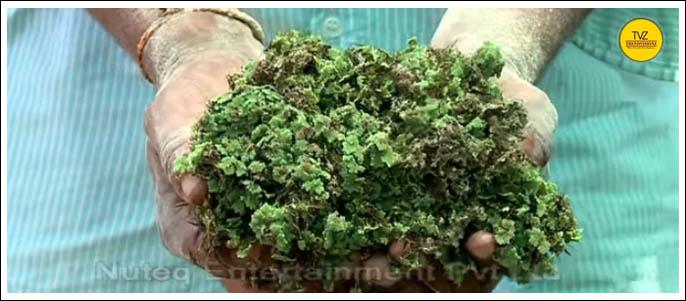
3. Mulching
Put in place mulching practices around the water body to prevent nutrient loss and maintain moisture. Organic mulch materials like dried leaves or straw create a protective layer. It reduces evaporation and preserving the nutrient content of the water. Mulching also promotes a healthy microbial environment. And contributes to the vitality of the Azolla cultivation system.
4. Avoid Chemical Pollutants
Reduce the use of chemical fertilizers, herbicides, and pesticides. Chemical pollutants can impact the growth and health of Azolla.
Also Read: Why gardening is good for your health : From Seeds to Serenity
What is Azolla pinnata used for?
Azolla pinnata is a cheap and safe substrate for growing mushrooms. Mixing Azolla with farm waste like rice straw or sugarcane bagasse makes a nutrient-rich base for growing mushrooms. Azolla has a lot of protein, which helps mushrooms grow and produce more.
Boosting Rice Cultivation with Azolla
A Winning Combo for Sustainable Agriculture
When you grow Azolla and rice together, they work well together to make agriculture more sustainable.
- Growth-Free Biofertilizer: Azolla improves the soil fertility in paddy fields as it fix nitrogen.
- Reduces Herbicide Usage: As Azolla grows, it makes a green mat on the water’s surface that keeps weeds from growing.
- Optimal Moisture Level: The dense Azolla cover also saves water by preventing it from evaporating.
- Natural Pesticide: Azolla also keeps some bugs away from rice plants because it is a natural pesticide.
Using this combination increases rice yields. And helps keep the soil healthy, saves water, and less affects the environment. This creates a sustainable and productive farming method.

Azolla Farming: Economic Benefits, Profitable and Sustainable Solution
Azolla farming is a good economic choice for farmers who want to increase animal production while cutting costs. To build a 6×4-foot pond, you only need to spend Rs. 500 on a covering sheet and work.
Less Input, Most Results: A farmer can earn more than Rs. 4,000 annually by getting more milk and using fewer concentrates to feed animals.
Azolla grows rapidly enough to harvest many times. Often as a cheap, nutrient-rich animal feed supplement. When farmers feed their animals Azolla, the animals produce more milk and grow faster, which helps the farmers make a lot of money.
Also, spending less on expensive concentrates helps save money even more. As more farmers start using the power of “wonder fern”, the economic benefits of Azolla farming will spread through communities. Inspiring others how it can improve agriculture and food production.
FAQ: Azolla Cultivation for Livestock Feed
How to Grow Azolla at Home?
Follow these easy steps to grow Azolla at home. Fill a shallow jar with clean water. Rainwater or freshwater is best. Put the pot where it will get indirect sunlight and be well-lit. Put a small amount of Azolla into the water and let it grow independently. With the right care and attention, you can grow Azolla at home and keep it going for a long time.
Where can you Buy Azolla?
You can get an Azolla plant from nearby farms. Also from local agriculture officers, Agricultural Universities, or Krishi Vigyan Kendra. You can also buy Azolla from an online store.
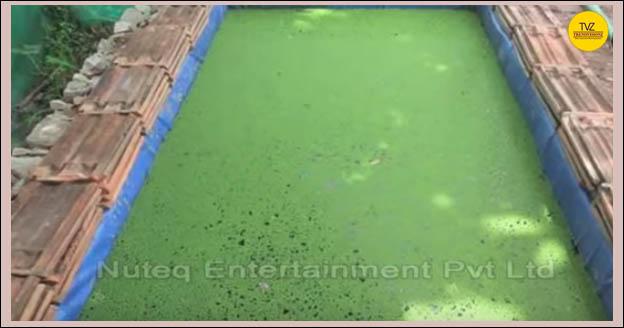
How is Azolla Harvested?
A fine mesh net is in use to skim the floating mats of Azolla from the water’s surface. Next, get rid of any extra water. After it is taken out. It is a nutrient-rich feed supplement for animals, a biofertilizer, or in other ways.
Conclusion
Azolla farming offers a sustainable and profitable solution for the livestock industry. It’s is an ideal protein feed for livestock.
By following the step-by-step best practices, farmers can cultivate and use Azolla. An ideal protein-rich feed for their livestock. Azolla farming also contributes to environmental sustainability. It reduces dependence on traditional protein sources and synthetic fertilizers. Embracing Azolla as a protein solution is a step towards a more sustainable and resilient future in animal agriculture.
Our Digital Imprints:
Anuj Mahajan is a Mass Communication Specialist,
ICF Certified Coach & Corporate Trainer. Motivational Speaker / NLP Lifecoach.
Chief Operating Officer: Nuteq Entertainment Pvt Ltd, and
Co-Founder: Trendvisionz – A Premier Digital Marketing Agency in India
Get Connected to us with our Newsletters-Transforming Lives… Creating the magic. Just – Believe ~ Practice ~ PerformBizTech Chronicle… Navigating Tomorrow’s Tech Frontiers 🚀
Join my LinkedIn Group: Digital Marketing, Content Creation World Group
Follow me on Twitter or LinkedIn. Check out my website.




